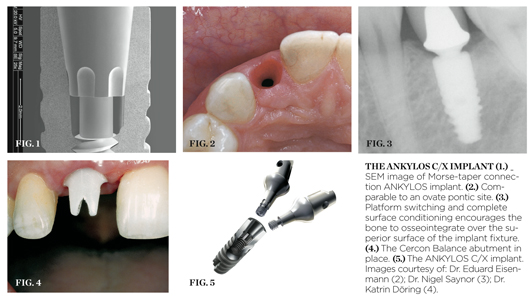ANKYLOS Implant
Supports fixed prosthodontic options.
The evolution of digital technology for medical application is always ahead of the curve when compared to dentistry. The recent availability of CT scan for the diagnosis and surgical planning for implant placement improves the predictability of prosthetic success like no other previous development. The esthetic expectations of today’s savvy patient can be more readily met with the use of software systems such as Simplant by Materialise, which uses the CT data to develop surgical guides to determine the optimum prosthetically driven fixture placement. Of more importance is the presurgical determination that the proposed treatment outcome is not possible with the currently available osseous structure and an augmentation or a change in prosthetic design is required.
Many complications associated with implant prosthodontics are diminishing with the corresponding application of evolving technology. Predictable implant treatment began with Dr. Brånemark’s flat-top external hex. The system was designed for multiple levels of failure opportunity in the prosthesis/abutment complex intended to protect the surgically placed implant body. Over time, advancement of the science has brought us to the current preference of internal abutment fixation. The superior engineering principles are obvious in hindsight, as the science has been properly developed, to the patient’s ultimate benefit. The ANKYLOS® system has been solidly entrenched in this approach for over 21 years with significant supporting research.
Since 1864, the Morse taper connection has been used throughout manufacturing when only the strongest, most stable interface will do. Jet and automobile engine mounts are two crucial examples where public safety is concerned. This key component of the ANKYLOS system is central to the many clinical benefits exhibited (Figure 1).
The stock abutment system provides a well-designed, long-term prosthetic result for the patient, eliminating the need for expensive CAD/CAM abutments required by other systems to accomplish similar soft tissue management. The unique conical connection of the abutment to the subcrestal implant body allows the clinician to determine the location of the inevitable biologic width. The abutment–gingival interface is best described as “comparable to an ovate pontic site” providing an exquisite tissue connection (Figure 2). Platform switching is a coexisting feature of this design that allows the bone to osseointegrate over the conditioned superior surface of the fixture (Figure 3). The resulting stability and lack of micro-movement normally associated with other implant systems combined with the healthy tissue connection are crucial to long-term gingival health. These factors combine to ensure a stable bone level unlike the accepted bone remodeling exhibited with other systems.
The prosthetic abutment selection is based solely on the restorative requirements and is exclusive of the implant diameter. The fact that there is a single-diameter fixture level impression coping and analogue eliminates potential errors at the impression and cast fabrication stages as well as minimizes inventory.
The ANKYLOS Balance Anterior Abutment is a non-indexed abutment that provides a natural scalloped margin design requiring minimal modification by the technician for ideal restorative results in the anterior maxilla. A Cercon variation (Figure 4) incorporates the same design features into a zirconium-oxide abutment, providing optimum esthetic properties at the gingival interface.
The absence of an indexed interface with the ANKYLOS implant has been a sticking point with many clinicians and technicians because of the need for a seating jig or matrix. This difference has prevented many from appreciating the simplistic prosthetic success the system provides. A properly fabricated seating matrix has been a valuable part of the abutment delivery for over 25 years. It allows the clinician to quickly place the abutment(s) intraorally with confidence that they are in the proper position, indexed or not.
The addition of the ANKYLOS C/X indexed implant system (Figure 5) removes this final comparative barrier. Most importantly, the addition of the index does not reduce the surface area of the conical connection and the stability it provides. The option to use the index or not, depending on prosthetic design, remains up to you and the technician.
For more information, contact:
DENTSPLY Tulsa Dental Specialties
Phone: 800-662-1202
Web: https://www.tulsadentalspecialties.com
Disclaimer
The preceding article was written at the request of, and is endorsed by, the manufacturer. The statements and opinions contained therein are solely those of the author and not of the editors, publisher, or the Editorial Board of Inside Dentistry. The preceding is not a warranty, endorsement, or approval for the aforementioned products or services or their effectiveness, quality, or safety on the part of Inside Dentistry or AEGIS Communications. The publisher disclaims responsibility for any injury to persons or property resulting from any ideas or products referred to in the preceding material.
Images courtesy of: Dr. Eduard Eisenmann (2); Dr. Nigel Saynor (3); Dr. Katrin Döring (4).
About the Author
This article was written by David Avery, CDT. Director of Professional Services, Drake Precision Dental Laboratory, Charlotte, NC. He can be reached at davery@drakelab.com.









